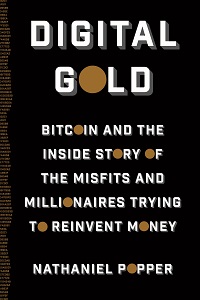 Is Bitcoin a high-tech pyramid scheme or an important piece of finance for the future? The value of the virtual currency soared to $1,200 in 2013 before crashing to about $100 in 2014 and recovering to $300-$500 more recently. That has added volatility concerns to those of viability. While many observers continue to scratch their heads about the ultimate value of the Bitcoin concept, others are investing in the idea that it will entirely change how finance works before long.
Is Bitcoin a high-tech pyramid scheme or an important piece of finance for the future? The value of the virtual currency soared to $1,200 in 2013 before crashing to about $100 in 2014 and recovering to $300-$500 more recently. That has added volatility concerns to those of viability. While many observers continue to scratch their heads about the ultimate value of the Bitcoin concept, others are investing in the idea that it will entirely change how finance works before long.
Knowledge at Wharton recently spoke with New York Times reporter and Bitcoin expert, Nathaniel Popper, to learn more about the digital currency’s emergence and where it may be heading. He explains how Silicon Valley and Wall Street are now locked in a power struggle over the future of Bitcoin technology, in which the former believes may allow it to wrest financial power from the latter.
Popper’s new book is titled, Digital Gold: Bitcoin and the Inside Story of the Misfits and Millionaires Trying to Reinvent Money. It is based on more than 300 interviews of people around the world, including Tyler and Cameron Winklevoss and Bitcoin’s elusive creator Satoshi Nakamoto.
An edited transcript of the conversation appears below.
Knowledge at Wharton: What drew you to the Bitcoin story? And why did you think it was an important story to tell?
Nathaniel Popper: I wrote the first story about Bitcoin for The New York Times in 2013. We were a bit late to the story because we hadn’t known how to approach it. Most editors thought it was some Tamagotchi-like trend that would hopefully pass, and we could ignore it.
A lot of other articles that had been written about Bitcoin focused on the technology, which is very complicated. But I wrote my first Bitcoin story about the Winklevoss twins and their $11 million stash of Bitcoins. Through them I could ask questions and understand why they thought Bitcoins were worth something. I asked, “How do you actually own Bitcoins? What do you do if you want to buy them?” All of these basic questions that people have.
The story ended up being the most-read story on The New York Times for a week afterwards. I still thought Bitcoin was some sort of gimmick that would pass, but the story resonated with people and I realized that something about the fundamental nature of money captured people’s imagination.
So I kept covering it over the next year and the price of Bitcoin went up and down. After about a year of covering it, book agents began writing to me to say, “There’s a great story here.” I kept focusing on the people, instead of the technology. I was diving deeper into the topic and seeing how many serious people were taking Bitcoin seriously. My colleague, Andrew Ross Sorkin, said to me one day, “This is a gold rush. This is a human tale. You have to tell it. You are in the middle of it. You have to tell this story.”
I was trying to understand why this idea resonated so deeply with people and I finally decided that it was worth spending a year of my life trying to understand it. I wanted to dive into it, talk to people and try to figure out where it came from. Most people thought it was a joke when it was founded. Even people who understand cryptography and the technology thought this was going to fail when it was first created in 2009. For two years, Bitcoins were worth nothing.
“My goal was to understand how we went from Bitcoin being a plaything to becoming something that central banks and Wall Street take seriously.”
Fast-forward to today. The Economist is featuring a cover story about how the technology underlying Bitcoin — the blockchain — is going to change every industry that involves trust. Every Wall Street bank has a working group looking at Bitcoin technology.
My goal was to understand how we went from Bitcoin being a plaything to becoming something that central banks and Wall Street take seriously.
Knowledge at Wharton: Let’s take a step back to ask, “What exactly is Bitcoin?” Tell us a little bit about how the underlying technology evolved.
Popper: If you come to Bitcoin fresh, you won’t get your head around it immediately. One of the hardest things to do is describe it. People get the wrong idea, because it is many things, not just one thing. A lot of people still think it’s some physical coin or just something that a company cooked up and sells. Ultimately, it is a digital token that moves around and can be traded. It’s a scarce digital token because only 21 million Bitcoins will ever be created. But that’s just the top layer.
Below that, it’s a new kind of financial network. Anybody can download and tap into this open source software that governs the way the tokens are created and the way the tokens move around. Once you tap into this network, you’re part of the Bitcoin network. You can get new Bitcoins as they’re being created. It is a new type of decentralized network.
There are many metaphors to describe Bitcoin. For example, it’s sort of like e-mail for money. It’s very hard to send value electronically, because what’s to stop somebody from copying and pasting your dollar bill in an e-mail and using it in another e-mail? But Bitcoin allows that. It’s also a bit like Wikipedia, where many people work together to maintain a network that everybody can use. It’s also like the Internet for money.
Many people who care about Bitcoin say that Bitcoin right now is like the Internet in 1994. Everybody in 1994 was asking, “Why should I care? There are only 5 million people who have e-mail addresses. Why do I need to participate? I don’t want to communicate with these professors who use e-mail. My friends don’t use e-mail. Why do I care about it?” People debated whether the Internet would be about communication or media or publishing. It took a long time for the basic infrastructure to develop. But once it did, it encompassed all of those things, including communication, media and publishing.
That’s one way of viewing Bitcoin and the blockchain. I’m not necessarily convinced we’re going to end up there. But the story of Bitcoin is really interesting since the fact that it’s already gotten so far is pretty amazing. All the Bitcoins in the world today are worth something in the neighborhood of $5 billion. Every venture capital firm in Silicon Valley has a Bitcoin or blockchain investment.
Let’s go back to the basic question, “What is it?” Ultimately, I wrote my book because I felt it was the only way to understand all the different ways of looking at this technology. It’s not just digital cash. It’s also this new kind of financial network that allows transactions to happen directly on the Internet. That wasn’t really possible before.
Knowledge at Wharton: You mentioned the investments that Silicon Valley venture capitalists have made in Bitcoin. One of the things I found really fascinating in your book is the tug of war that seems to be going on between Silicon Valley and Wall Street. Could you lay out what the fight is all about — and the implications?
“There’s no small amount of irony in the fact that Bitcoin was designed to disrupt and circumvent Wall Street and central banks. But the two parties that are currently most interested in using Bitcoin are central banks and Wall Street.”
Popper: I tell a story in the book about previous technological efforts to create digital cash and disrupt Wall Street. Some of this was in the hacker community. The cypherpunks in the 1990s wanted to create digital cash so that the government wouldn’t be able to trace their credit card transactions. Essentially, the Edward Snowdens of the world wanted to bring the anonymous nature of cash into the digital world. Experiments were going on that led to things like DigiCash in the 1990s, which ended up failing.
At the same time, you had Paypal, which originally set out to be like Bitcoin. Paypal wanted to create a financial system that was outside of government. So, for example, people in Argentina could use Paypal to move their money when the Argentine peso was failing to another economy where the currency was working.
PayPal actually failed in its big ambitions. It’s now a big, successful company. But the guys who founded it — Peter Thiel and Max Levchin — sometimes talk about it as a failure. Now it’s just another payment rail that works in the same way as Visa and American Express. But part of the PayPal story was the ambition to circumvent the existing financial industry.
There has been recognition in Silicon Valley that they haven’t really touched finance. Silicon Valley has disrupted many other industries, including media and publishing. But finance kept its little circle closed and kept its business. For example, only banks held and hold money and only banks make financial transactions. PayPal touched that, but it’s really just an intermediary between banks. So Wall Street has remained the center of power and influence in the United States.
But these PayPal guys were slowly won over to Bitcoin. People like Peter Theil and Marc Andreessen are now saying, “This is our chance to disrupt Wall Street and get into businesses such as payments and deposits.”
Silicon Valley is now challenging Wall Street in a way that hasn’t really happened before. There’s a sense of confidence and boldness in Silicon Valley right now, with people thinking, “This is our moment. This is where we challenge the center of power in the United States and we become that power.”
Bitcoin is not the entirety of that challenge. But it’s an interesting way to understand how Silicon Valley wants to challenge Wall Street, by providing a decentralized network like the Internet to challenge the centralized, powerful financial industry.
Knowledge at Wharton: What is Wall Street doing to fight back?
Popper: Over the past year, Wall Street has become the industry that is most interested in this technology. There’s no small amount of irony in the fact that Bitcoin was designed to disrupt and circumvent Wall Street and central banks. But the two parties that are currently most interested in using Bitcoin are central banks and Wall Street. There are now Bitcoin blockchain conferences every week and they’re all sponsored by groups like Citigroup and Santander. Attendees include people from the Bank of England and the Federal Reserve.
Banks are trying to harness this technology, but not necessarily in obvious ways. For example, they’re looking at creating their own payment networks to make instant transfers. Right now, the dominant automated clearinghouse (ACH) network takes two to three days to make a basic bank transfer. The banks want that to happen faster and they think the blockchain system might help them make instant transactions, which would please consumers.
They’re also talking about using this technology to settle bigger transactions, including stock, bond and loan transactions. The Nasdaq exchange just recently unveiled a blockchain system for settling some trades. They’re going to start trading shares of private companies on their own blockchain system.
“The Nasdaq exchange just recently unveiled a blockchain system for settling some trades. They’re going to start trading shares of private companies on their own blockchain system.”
To understand what the blockchain is, you have to understand that there’s Bitcoin, which is a type of currency that exists and trades on a network of computers. Those networks are keeping a ledger of transactions, which is being communally maintained around the world. That big ledger is the blockchain.
So people are now thinking that anything that is kept on a database or centralized ledger is something that could be disrupted by this blockchain concept. For example, previously people had to rely on a mortgage company to determine if somebody had the title to a certain mortgage. But it might be better if you went to check a decentralized, reliable database that everybody held. That would allow you to find the information you need about a mortgage.
Of course, this is looking way ahead. The beginning of the story starts with digital cash. But you get from that to talking about a new way of recording property everywhere in the world. This gives you a sense of why I got interested in this and why people get so passionate about it. Once you start thinking about it and what it could mean, it’s pretty exciting.
Meanwhile, Bitcoin itself is still there and the currency continues trading on the network. They’re still building up towards 21 million Bitcoins. But using Bitcoins for online purchases hasn’t worked out as well as people expected. And people have sometimes treated it like a digital gold rush and invested in it, but sometimes the price goes up and sometimes it crashes. People have lost a ton of money on this.
I also think some of the economics of the Bitcoin system are flawed. The shadowy creator of Bitcoin — Satoshi Nakamoto — wrote a lot of papers about what he hoped would happen, but it hasn’t necessarily worked out as anticipated.
So this hasn’t exactly been a wonderful triumph. There have been a lot of failures. But it’s an experiment that you can watch unfold in the real world.
Knowledge at Wharton: Tell us about trust in this system.
Popper: Trust is the fundamental issue from the consumers’ perspective. But whether it’s Bitcoin or something else, digital money is here to stay. There aren’t a lot of people who have bought things with Bitcoin right now, but many people have made online purchases with their credit card. That’s digital money. People have trust in the credit card system and confidence that they will get what they paid for. Bitcoin is a variation of a payment system and it operates in the consumer’s self-interest, so that’s why it’s going to work.
On this question of trust, it’s important to note that Bitcoin went from being worth nothing to being worth anything at all. How did it create that network effect and pick up users? The way that Bitcoin originally created this network effect was through something called Silk Road, which was a drug website. Silk Road was really the first place where you could use Bitcoin and it proved that Bitcoin worked. Before Silk Road came along in 2011, Bitcoins were worth almost nothing. Then in the first four months that Silk Road existed, Bitcoin’s value went from 50 cents to $30 each. Bitcoin allowed you to do something that you couldn’t do before — for example, send money to Amsterdam to pay for heroin. The transactions went through every single time and you didn’t have to go through an intermediary. You can view this as a black mark on Bitcoin’s history, but some people thought, “Wow. Somebody is sending $100 to Amsterdam to somebody they don’t know and the money is getting there every single time.” This is the greatest thing about Bitcoin because it’s a transaction that happens between two untrustworthy people. That is what Bitcoin has to offer that existing systems do not. It has worked for illegal transactions, gambling and drugs.



